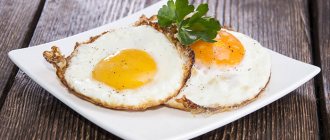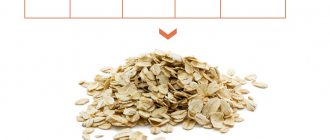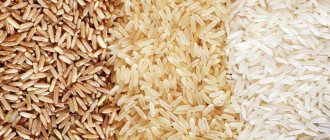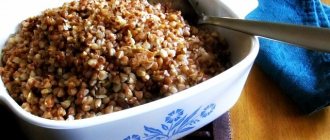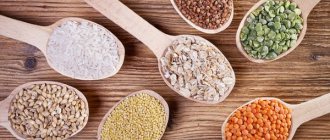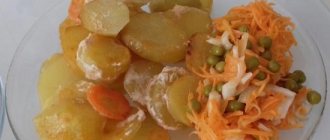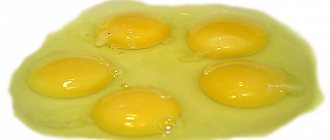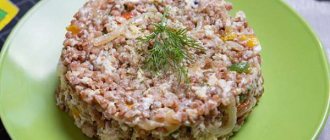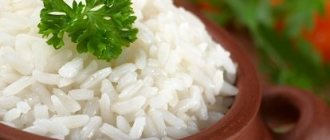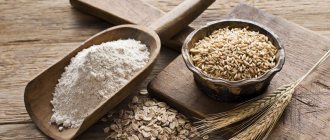A quick answer for the impatient: the calorie content of wheat porridge with water per 100 grams of product is 92 kcal. Read all other numbers below.
Everyone who wants to get rid of extra pounds most often focuses on oatmeal and buckwheat, forgetting about such a wonderful product as wheat porridge. Despite the fact that the calorie content of wheat porridge is quite high, this is not a reason to exclude it from the diet.
If cooked correctly, the calorie content of this dish will be very close to buckwheat. Moreover, there are a lot of interesting and original dietary recipes that will help you rediscover this healthy porridge while maintaining a slim figure.
Calorie content of wheat porridge per 100 grams of product
How many calories are in wheat porridge? Everything will depend on many factors. The energy value of any porridge in dry form will be much higher than in its finished form. So, if in a dry state there are 340-350 kcal per 100 grams of cereal, then for porridge cooked in water this figure is more than three times lower!
This can be explained simply - during the cooking process, under the influence of high temperatures and water, the cereal boils and swells, increasing in size several times.
On average, the number of calories per hundred grams of product in various preparations is as follows:
- Wheat porridge on water - 92 kcal;
- Wheat porridge on water with added sugar - 122 kcal;
- Wheat porridge on water with butter - 161 kcal;
- Wheat porridge with milk - 107 kcal;
- Wheat porridge with milk and butter - 195 kcal;
- Wheat porridge with pumpkin - 178 kcal;
- For gourmets with condensed milk and prunes - 260 kcal.
An important tip concerns storing purchased cereals. You cannot store this porridge for a long time in an open package (meaning packaged kilogram packs) as it will begin to taste bitter.
Therefore, it is better not to delay its preparation. Fortunately, there are quite a lot of recipes using wheat - both raw and cooked.
Often people prefer to eat wheat porridge cooked in milk with the addition of butter and sugar. Of course, this is a very tasty, but also wildly high-calorie type of dish. Therefore, you should not abuse it. It’s better to eat this option for breakfast so that your body has the opportunity to spend the resulting carload of calories during the day.
Chemical composition, nutritional and energy value
Regardless of the variety, wheat cereal is rich in complex carbohydrates and fiber, as well as vitamins and minerals. In particular, wheat is an excellent source of fiber, which:
- promotes digestive health;
- reduces cholesterol and blood sugar levels;
- helps maintain weight and promotes proper bowel function.
Wheat porridge contains plant estrogens, which reduce the risk of developing certain types of cancer, especially when combined with minerals such as magnesium, selenium, copper and manganese. Wheat porridge is a major source of complex vitamins, including thiamine, folic acid and vitamin B6.
| Substance | Amount, mg (per 100 grams) | % Daily Value |
| Manganese | 0,26 | 38,2 |
| 126.89 mcg | 37,1 | |
| Phosphorus | 93,2 | 34,1 |
| 1,589 | 25,9 | |
| 0,171 | 25,1 | |
| Cobalt | 0,717 | 21 |
| Molybdenum | 4,43 | 18,6 |
Wheat cereal is one of the most popular in Russia. The reasons for this are its very economical price, excellent taste and great benefits. In addition, wheat cereal is versatile: it can be boiled in water or milk, flavored with fruits, honey, nuts, sweetened or added with salt - in any form it will suit everyone’s taste.
Benefits of wheat for weight loss
Like other cereals, wheat is a rich source of natural fiber, which, like a sponge, passes through our stomach and intestines, removing all harmful substances from their walls. It normalizes the digestion process and is considered effective against dysbiosis.
Doctors evaluate wheat porridge as a good preventative against constipation and other gastrointestinal ailments.
The fiber supplied to the body by wheat porridge normalizes the process of fat metabolism in cells, which is often disrupted in people who are overweight. In addition, it naturally removes waste and toxins from the human body.
If you include wheat porridge in your regular diet and eat it regularly, it will improve the condition of blood vessels. Wheat porridge is rich in special components that increase the elasticity and firmness of vascular walls.
Wheat porridge contains vitamins of groups A, B, E, C and PP, as well as such useful microelements as:
- magnesium;
- phosphorus;
- calcium;
- iron;
- potassium.
Thanks to such a rich composition, wheat porridge is a recognized preventative against the development of diseases of the heart and central nervous system. It normalizes metabolism and strengthens the immune system.
What else is wheat porridge good for?
Advice from nutritionist Irina Shilina Healthy eating is incompatible with strict dietary restrictions, malnutrition and prolonged fasting. Today there is no need to strive for abnormal thinness by depriving yourself of food! Check out the latest weight loss techniques for 2022. Find out the secret ->
- B vitamins contained in wheat porridge have a positive effect on the level of red blood cells in human blood.
- Regular consumption of this dish improves the general condition of the body: vision becomes clearer, the skeletal system is strengthened, hair shine and skin elasticity appear.
- Wheat porridge is famous for having a low glycemic index. This allows it to regulate glucose levels in the body, which is a particularly important factor for people who are struggling with excess weight or for those suffering from diabetes.
- Wheat can compensate for the deficiency of carbohydrates and proteins. At the same time, it is rich in so-called slow carbohydrates, which the body spends a lot of time and effort processing. Therefore, even despite the high calorie content, it is quite difficult to gain weight on wheat porridge.
- It should be noted that it is beneficial for people who struggle with high cholesterol in the blood. With its help, it will become easier to control its level.
- Helps lower blood pressure and helps remove cholesterol plaques from blood vessels.
- Wheat cereal also contains mono- and polyunsaturated fatty acids. Thanks to this, it helps to improve attention, which is especially important for schoolchildren and students for better performance and high-quality memorization of educational material.
It is noteworthy that many doctors recommend introducing wheat porridge into their diet for patients who have recently undergone treatment with antibiotics. It turns out that wheat can effectively remove the remnants of these medications from the body.
Composition and amount of calories
Cereals are made from crushed durum wheat. 100 g of product contains about 300-350 kcal. It would seem that this is not so little, but the calorie content of boiled wheat is significantly reduced.
For example, porridge with water will contain a maximum of 100 kcal.
That is, you can even add sugar or butter to this dish in reasonable quantities, and then the calorie content will increase to 140 kcal. In addition, you can prepare many different dishes from porridge cooked in water - these include side dishes, breakfasts, and even dessert casserole.
If the cereal is prepared with milk, then the calorie content reaches 210 kcal per 100 g of product.
This porridge is good for baby food. You can add fruits, berries, raisins, and nuts to it. And even despite its high calorie content, a dairy dish is a healthier side dish than, for example, potatoes or pasta.
Wheat porridge is often included in diets. A large amount of fiber improves the functioning of the digestive organs. Insoluble fiber ensures the timely elimination of undigested foods. Soluble substances help reduce glucose levels and reduce the density of cholesterol lipoproteins in the blood.
If cereals are used as the basis of a diet or a healthy diet, then you can make flatbreads from it and replace bread with them. But the most beneficial intake of wheat porridge is possible in the morning. The fact is that the dish provides the human body with a charge of energy and allows you to be full until lunch.
That is, a breakfast of wheat porridge will get rid of unplanned snacks that are harmful to your figure, and will also promote active physical activity, which will certainly have a positive effect on weight loss.
If wheat porridge is used as the basis of a diet, then several important rules must be followed:
- drink at least 2 liters of clean water per day, it is better to do this before meals;
- porridge cannot be salted, sweetened or flavored with oil;
- During the diet, only herbal tea and fermented milk products are allowed from liquid;
- you can add sweet cinnamon, herbs and vegetables to the porridge;
- You need to take 4-5 servings of porridge per day.
In a week, such a diet will allow you to get rid of extra 3-4 kilograms. Unlike other options, losing weight on wheat porridge is practically safe. This is due to the rich composition of the cereal, which replenishes the body’s need for other substances. The porridge contains the following vitamins:
- B4 – cleanses the liver;
- B5 – improves brain activity and memory;
- B2 – prevents vision deterioration;
- B1 – protects body cells from radiation;
- E – prevents the formation of blood clots;
- A – promotes skin rejuvenation;
- PP – gives the body energy.
Who should abstain from wheat porridge?
However, despite the high nutritional value, there are a number of contraindications to eating wheat porridge.
- May cause harm to people diagnosed with celiac disease (or celiac disease). This is a digestive disorder in which people cannot eat any grains, not just wheat.
- Among the more common diseases, the list of contraindications for eating wheat porridge also includes gastritis, but specifically gastritis accompanied by low acidity.
- If you chronically suffer from flatulence and bloating, then you are also advised to limit your consumption of this dish.
- It should be abandoned in the postoperative period, especially if a person has undergone surgery on the functioning of internal organs. But this ban is temporary, and you can return wheat porridge to your diet as soon as your doctor allows it.
But healthy people also need to take a reasonable approach to shaping their daily diet and not constantly consume wheat porridge for breakfast, lunch and dinner.
If you abuse its quantity, it can be fraught with a feeling of heaviness in the stomach due to excessive intestinal motility. Dilute your menu with fresh vegetables and fruits to avoid this.
Be careful when purchasing. Low-quality cereals can cause allergic reactions and digestive tract disorders in humans. Therefore, it is recommended to buy cereals packaged in bags.
Look carefully at the appearance of the grains. They should be crumbly and the same color. If you notice impurities of a clearly different shade in the cereal, this may be a sign that mold or mildew has formed in it. They can cause allergies and other health problems.
Composition of wheat cereal
Wheat groats are obtained by grinding wheat grains, clearing them of the germ, as well as fruit and seed coats. In our territories, two types of grain are most often used: soft and hard. Soft wheat is used to make flour for the baking and confectionery industries. Durum wheat varieties are used to prepare high-quality cereals and pasta. When processed, the grains are the same size, so they are boiled at the same time, which means this grain is very easy to prepare.
Did you know?
It is not for nothing that the second name of wheat is “the queen of cereals.”
It was first cultivated in Mesopotamia in the 7th century BC. e., since then, century after century, this culture has gained popularity on different continents: first it conquered Asia and the Iberian Peninsula, then Africa and Europe. Finally, since the 19th century, wheat has become in demand in North and South America and Australia. Thus, wheat has become the most exported grain crop in the world - its exports account for 3/5 of the total grain trade. Its chemical composition is impressive: 100 grams of cereal contains 2 times more than the required daily intake of many substances, for example, manganese and silicon.
| Vitamins | |
| (AT 4) | 90 mg |
| 7.7 mg | |
| Alpha tocopherol () | 6 mg |
| Niacin (B3) | 5 mg |
| Riboflavin () | 1.8 m |
| Pantothenic acid () | 1 mg |
| Pyridoxine () | 0.5 mg |
| Thiamine () | 0.2 mg |
| Folic acid () | 40 mcg |
| Biotin () | 10 mcg |
| Macronutrients | |
| (TO) | 300 mg |
| (Ph) | 250 mg |
| (Sa) | 250 mg |
| (S) | 100 mg |
| (Si) | 50 mg |
| (Mg) | 50 mg |
| (Cl) | 30 mg |
| (Na) | 25 mg |
| Microelements | |
| (Mn) | 3.8 mg |
| (Zn) | 2.8 mg |
| (Fe) | 2 mg |
| Aluminum (Al) | 1500 mcg |
| Copper (Cu) | 500 mcg |
| Boron (B) | 200 mcg |
| Other elements | |
| Starch | 50 g |
| Sahara | 2 g |
class=”table-bordered”> Among other microelements, wheat cereal contains in small quantities: vanadium, strontium, nickel, tin, molybdenum, titanium, zirconium, selenium, iodine, which our body also needs.
Gluten content in cereals
Almost all cereals contain gluten, but it can cause severe allergic reactions, and 0.1 g is enough for this. Intolerance to this protein is observed in approximately 1/3 of the population, children are most susceptible to it.
Experts recommend that people at risk eat gluten-free cereals:
- buckwheat;
- millet;
- rice;
- corn;
- quinoa.
Its highest content is in semolina, pearl barley, oatmeal and wheat groats.
Warning! Even a small amount of gluten is contraindicated for people prone to allergies.
It gradually destroys the intestinal epithelium and can trigger a number of gastrointestinal diseases.
Sweet porridge with pumpkin
Wheat porridge, the benefits of which are due to the carotene in its composition, with pumpkin can become a nutritious and valuable breakfast recommended for children. The combination of pumpkin and wheat can improve the functioning of the stomach and intestines and effectively cleanse the body of toxins. You can complement the taste of this porridge with dried apricots, prunes, nuts or pumpkin seeds.
Required Products:
- wheat cereal – 1 cup;
- pumpkin – 300 g;
- water – ½ cup;
- milk - 3 cups;
- salt, sugar, butter - to taste.
Cooking method:
- Peel the pumpkin, cut into small cubes;
- In a thick-bottomed saucepan, salt the pumpkin and pour boiling water over it;
- simmer for 10 minutes. under the lid;
- adding milk and sugar, bring to a boil;
- add the washed cereal and cook over low heat for 20 minutes;
- leave the finished porridge covered for 30 minutes;
- You can add cream or butter before serving.
Calorie content
Calorie content of wheat porridge per 100 grams of dry product
Eating wheat porridge is very profitable, it is inexpensive, but it is filling, and the benefits will be obvious. If you cook it for breakfast with milk, sugar and butter, you will definitely have enough energy until lunch and still have some left over. Cereals are divided into two types:
- “Artek” finely crushed polished grain;
- “Poltavskaya” is uncrushed and coarsely crushed polished grain.
In addition, instant cereals and semolina are produced from wheat. Wheat comes in hard or soft varieties, so soft semolina is not suitable for dietary nutrition, but the benefits of porridge for those losing weight are very noticeable.
You can prepare any dish based on it: porridge with milk, dietary porridge with water, salty or sweet, with spices, it can contain all kinds of additives, fruits, nuts, dried fruits, meat, canned food.
With milk
If you like a more viscous porridge, then try cooking from the Artek brand, it boils quickly and well, it only takes 15 minutes. Calorie content is only 100 kcal/100 g.
Calories in milk
| Name | Quantity | fats | carbohydrates | squirrels | Total kcal |
| Wheat porridge | 60 gr | 1 g | 37 g | 7 g | 185 |
| Milk | 125 ml | 5.4 g | 4 g | 64.7 | |
| Water | 100 ml | ||||
| Total calories per 1 serving/250 g | 57.6 kcal | 148 kcal | 44 kcal | 250 |
On the water
If you cook porridge in water, you will get a delicious side dish or a dish on its own. Calorie content is only 115 kcal/100 g. Before cooking, the cereal can be rinsed to drain off excess flour, but if you like a sticky consistency, do not rinse. Porridge with butter and sugar will be tastier, but the calorie content will increase by about 50 kcal/100 g.
THESE ARTICLES WILL HELP YOU LOSE WEIGHT
What other products are made from wheat?
Not only cereals, but also other valuable products are obtained from wheat grains.
Semolina
Everyone's least favorite (or favorite) semolina since childhood is made simultaneously with the grinding of wheat into flour. These are large particles of crushed endosperm. In Russia, the production of semolina is controlled by GOST 7022-97. According to him, cereals are divided into the following types:
- M - soft wheat, cream or white, without transparency of particles;
- MT – from soft wheat (with the addition of durum in an amount of up to 20% of the total weight), translucent;
- T – exclusively made from durum, yellowish and translucent.
In addition to preparing porridges, semolina is used in casseroles and baked goods.
Flour
Flour is considered the most valuable wheat product. Bread and similar products are baked from it, and added to various dishes and sauces. Bread flour is made from soft wheat, which has a high gluten content. Durum flour is used to make pasta or for home use.
Stages of flour production:
- The grain is checked for quality.
- If necessary, dry and then clean from organic debris.
- The raw materials are moistened in 3 stages and ground to a powdery state, and then sent to an industrial sieve. Sorting by size takes place here. The finest particles obtained from the core are packed like fine flour. Grade 1 – larger particles. Grade 2 is flour made from material close to the grain shell.
Pasta
Pasta is present in the human diet as a side dish for main courses, as an additive to soup or casserole. They are made from durum wheat flour. To do this, sift the flour, mix it with purified water and roll the resulting dough into a thin layer. After this, special knives cut the dough and send it to shape. In this way, many different types of this product are obtained: vermicelli, cones, spirals, spaghetti, etc.
Alcohol
A clear liquid with a pungent odor is used in many areas. Alcohol is used in the production of alcoholic and cosmetic products, medicines and household chemicals.
The grain is sorted by size and cleaned of dust and various impurities. After this, the raw materials are boiled, thus releasing the starch for further stages of production. The resulting homogeneous mass is saccharified and subjected to the process of fermentation and distillation, after which the alcohol is purified and sorted into containers.
Diet recipe
Wheat porridge, the benefits of which are obvious when losing weight, will help maintain optimal weight. Since porridge is a complex carbohydrate, it gives a long-lasting feeling of fullness . And the low calorie content and high fiber content promote weight loss.
Cooking process:
- Wash coarse wheat grits well;
- pour boiling water and bring to a boil;
- For a glass of cereal you will need 2.5 cups. water;
- cook over low heat for 20 minutes;
- leave for 30 minutes. under the lid;
- Divide the finished porridge into 5 servings and eat throughout the day.
The main condition of the dietary recipe is that the porridge should be cooked in water, without salt, sugar and fat. If the taste seems too bland, nutritionists allow additions to the porridge - fresh vegetables, herbs, garlic, spices, a small amount of nuts or dried fruits. Alternatively, you can eat it with low-fat kefir or unsweetened yogurt without fruit additives.
It should be understood that adding milk or butter turns diet porridge into regular porridge.
Nutritionists do not recommend eating only this kind of porridge for a long time. The best option is to have fasting days on dietary wheat porridge.
Calorie content of different types of cereals in finished form
Flax seeds: calorie content per 100 g, proteins, fats, carbohydrates
As a rule, the calorie content of the dry ingredient and the finished dish do not match. This is explained by the fact that during the cooking process the component changes its structure, becomes soft, and becomes heavier.
The calorie content of prepared food is influenced by several factors:
- original ingredient;
- what the food is prepared with: water, milk (the percentage of fat content is taken into account);
- the presence of additional spices (sugar, salt) and additives (butter, honey, dried fruits, berries).
The less additional components are used during the cooking process, the more dietary the finished dish will be. People who want to lose weight are recommended to eat porridge in the first half of the day.
How to select and store
Rolled oatmeal: calories per 100 g, proteins, fats, carbohydrates
When purchasing wheat cereal for porridge, study its appearance. High-quality wheat cereal has a uniform color (dark yellow or gray-brown), it is dry, without litter, lumps and mold.
Check the tightness of the packaging; if it is broken, then moisture has entered the product. In addition, on the way from the store, the cereal may simply wake up.
Check the production date. The highest quality porridge will be obtained from cereals produced during the wheat harvest season. This is July-August.
Storage conditions. Keep wheat cereal in a dry, ventilated place, out of direct sunlight. The shelf life of the cereal is about 10 months. After purchasing, the cereal can be poured into a glass or plastic jar. Do not store cereals with strong-smelling foods.
Everyone who wants to get rid of extra pounds most often focuses on oatmeal and buckwheat, forgetting about such a wonderful product as wheat porridge. Despite the fact that the calorie content of wheat porridge is quite high, this is not a reason to exclude it from the diet.
If cooked correctly, the calorie content of this dish will be very close to buckwheat. Moreover, there are a lot of interesting and original dietary recipes that will help you rediscover this healthy porridge while maintaining a slim figure.
Application
A dish made from wheat cereal is widely used in the diet of people of all ages, from young to old. Wheat porridge is also included in the diet menu of overweight people, in the diet of people suffering from various gastrointestinal diseases, as well as in the children's menu.
For good health
For good health, appearance and good health, nutritionists recommend adding porridge to your daily diet. To avoid monotony and get a full set of vitamins, porridge can be alternated on different days of the week, and for wheat porridge, choose, for example, Monday. You need to eat 1-2 servings of this dish per day for breakfast or lunch. The average serving should be about 250 grams (finished product), which fits in a small cup or equal to the size of your fist.
For weight loss
For people who want to lose excess weight, wheat porridge can be a real salvation - a diet based on wheat groats does not deplete the body, does not deprive it of important nutrients, but, on the contrary, perfectly saturates and fills it with everything necessary. In addition, you can add variety to your wheat porridge diet with a variety of vegetables, herbs, and unsweetened fruits (grapes and bananas are prohibited).
Depending on your initial weight, health status, metabolic rate and other individual factors, you can lose about 3-4 kg of weight in 7 days of eating wheat porridge. However, certain rules should be followed:
- maintain a drinking regime - clean water should be at least 2 liters per day, it is especially important to drink a glass of liquid before main meals;
- Drinks allowed include herbal and green tea, low-fat fermented milk products,
- When cooking, do not add salt, do not sweeten the porridge, do not use oils;
- Among the spices, it is permissible to use cinnamon for a sweet version, herbs for porridge with vegetables;
- During the day you need to eat 4-5 servings of the dish in small quantities.
For complementary feeding
Starting from 8 months, the baby can be introduced to this product, following certain recommendations:
- When offering porridge to your baby for the first time, do not exceed the dosage of half a teaspoon;
- in the absence of a negative reaction to the product, the amount can be doubled with each subsequent time;
- It is better to give porridge during breakfast;
- after the introduction of the previous product and before becoming familiar with wheat porridge, at least 3 weeks should pass;
- When cooking, do not use sweeteners, milk, butter or other ingredients;
- porridge must be cooked in water;
- the finished product should be as liquid in consistency as possible.
Beneficial features
The benefits of buckwheat and calorie content, proteins, fats, carbohydrates (kbju)
One of the main beneficial properties of wheat porridge is the normalization of fat metabolism. This effect is due to the composition of the product: sulfur, manganese, zinc, vitamins B, E, A, K, linoleic acid and proteins.
Wheat porridge contains a lot of peptins and fiber, which help cleanse the body of toxins and normalize intestinal function. For this reason, this product is indicated for people suffering from constipation and other disorders of the gastrointestinal tract.
Porridge is also worth eating because it contains folate, a water-soluble vitamin, the presence of which plays a significant role in the process of hematopoiesis. To get a daily dose of this element, it is enough to eat 150 g of cooked cereal.
In most cases, raw materials from crushed grain are used for porridge.
It is important to understand that the coarser the grind, the more nutrients, vitamins and fiber are retained in the product.
There are other beneficial properties of wheat porridge:
- Strengthening the immune system and blood vessels. This happens due to the high concentration of ascorbic acid.
- Energy replenishment. Wheat cereal helps to quickly recover for those who are faced with significant physical activity.
- Freeing the intestines from pathological microflora. The fiber contained in coarsely crushed wheat is responsible for this.
- Improving the condition of skin, nails and hair. Thanks to the presence of vitamins A and E in the porridge, hair acquires shine, the skin becomes elastic, and nails become stronger.
- Reduces bad cholesterol and eliminates saturated fats. This effect is possible due to the presence of fiber in wheat cereals, which acts as a scrub for the intestines. For the same reason, porridge will fit perfectly into the weight loss menu.
- Recovery after antibiotic use. Eating wheat porridge helps restore the body to its previous state after suffering a serious illness. Treatment with various chemicals and antibiotics significantly weakens the immune system; porridge is a product that can correct this.
- Calms the nervous system and improves memory. This effect is the result of the influence of vitamin B.
- Preservation of the youthful state of internal organs. This is facilitated by a set of amino acids contained in wheat grains.
Since wheat porridge has a low glycemic index, it is suitable for people suffering from diabetes and colitis.
Cooked cereal helps improve the digestive process and satisfies hunger for a long time. This product also ensures proper functioning of the intestines, resulting in trouble-free bowel movements, release of waste and elimination of toxins. Due to its low calorie content, lack of fat and high protein content, the dish is suitable for baby food.
